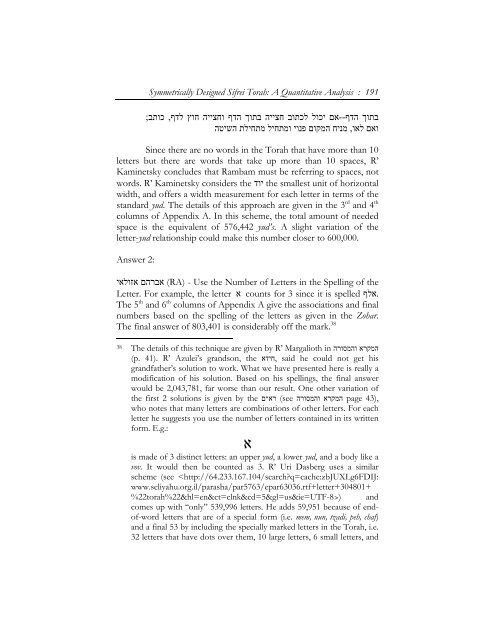Symmetrically Designed Sifrei Torah: A Quantitative Analysis - Hakirah
Symmetrically Designed Sifrei Torah: A Quantitative Analysis - Hakirah
Symmetrically Designed Sifrei Torah: A Quantitative Analysis - Hakirah
You also want an ePaper? Increase the reach of your titles
YUMPU automatically turns print PDFs into web optimized ePapers that Google loves.
<strong>Symmetrically</strong> <strong>Designed</strong> <strong>Sifrei</strong> <strong>Torah</strong>: A <strong>Quantitative</strong> <strong>Analysis</strong> : 191<br />
בתוך הדף--אם יכול לכתוב חצייה בתוך הדף וחצייה חוץ לדף,<br />
ואם לאו, מניח המקום פנוי ומתחיל מתחילת השיטה<br />
כותב;<br />
Since there are no words in the <strong>Torah</strong> that have more than 10<br />
letters but there are words that take up more than 10 spaces, R’<br />
Kaminetsky concludes that Rambam must be referring to spaces, not<br />
words. R’ Kaminetsky considers the יוד the smallest unit of horizontal<br />
width, and offers a width measurement for each letter in terms of the<br />
standard yud. The details of this approach are given in the 3 rd and 4 th<br />
columns of Appendix A. In this scheme, the total amount of needed<br />
space is the equivalent of 576,442 yud’s. A slight variation of the<br />
letter-yud relationship could make this number closer to 600,000.<br />
Answer 2:<br />
(RA) - Use the Number of Letters in the Spelling of the אברהם אזולאי<br />
.אלף counts for 3 since it is spelled א Letter. For example, the letter<br />
The 5 th and 6 th columns of Appendix A give the associations and final<br />
numbers based on the spelling of the letters as given in the Zohar.<br />
The final answer of 803,401 is considerably off the mark. 38<br />
המקרא והמסורה 38 The details of this technique are given by R’ Margalioth in<br />
(p. 41). R’ Azulei’s grandson, the ,חידא said he could not get his<br />
grandfather’s solution to work. What we have presented here is really a<br />
modification of his solution. Based on his spellings, the final answer<br />
would be 2,043,781, far worse than our result. One other variation of<br />
the first 2 solutions is given by the רא״ם (see המקרא והמסורה page 43),<br />
who notes that many letters are combinations of other letters. For each<br />
letter he suggests you use the number of letters contained in its written<br />
form. E.g.:<br />
א<br />
is made of 3 distinct letters: an upper yud, a lower yud, and a body like a<br />
vov. It would then be counted as 3. R’ Uri Dasberg uses a similar<br />
scheme (see ) and<br />
comes up with “only” 539,996 letters. He adds 59,951 because of endof-word<br />
letters that are of a special form (i.e. mem, nun, tzadi, peh, chaf)<br />
and a final 53 by including the specially marked letters in the <strong>Torah</strong>, i.e.<br />
32 letters that have dots over them, 10 large letters, 6 small letters, and
















